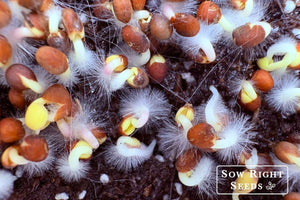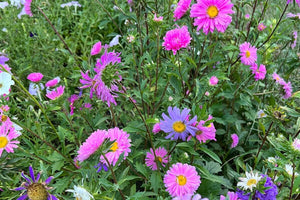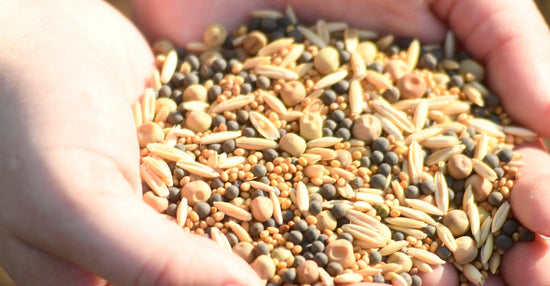Empower the Next Generation - 10 Heirloom Plants You Need to Grow from Seed
As gardeners, we hold the past and the future in our hands. Every seed we sow has a history and can contribute to the future. Heirloom plants are unique because they come from seeds that have been saved and handed down for generations.

When we choose to plant heirloom varieties, we ensure a more diverse food landscape. And the history of these delicious, beautiful, and useful plants will be available for the next generation of gardeners.
We’re pleased to offer these unique heirloom seeds, including flowers, herbs, and vegetables.
These heirloom seeds were once popular and are reemerging as more than just nostalgia. They have a lot to offer a new generation of gardeners as well.
Why are heirloom seeds different from hybrids?
Heirloom seeds will give you the opportunity to share seeds from plants that performed well in your garden. It’s another way to create a sustainable garden.
Technically, heirloom seeds are 50 years old. But if you want to get an antique, try these heirloom plants that are over 100 years old.
Heirloom Plants to Grow This Year
Ground Cherries

Ground cherries originated in Central America and have been grown for centuries. This rare tomatillo-like plant produces an abundance of golden fruits with a pineapple-vanilla flavor. Ground cherries are so easy to grow you won’t even have to figure out when it’s time to harvest. When the fruit is ripe, it falls to the ground.
Foodies and gardeners alike will enjoy this almost-forgotten but tasty heirloom.
Hollyhock Flowers

Hollyhocks are believed to be the oldest cultivated flowers. Extremely popular in Elizabethan and Victorian times, these flowers may be even older than that. They have been cultivated in China for thousands of years.
Hollyhock flowers can grow tall and look beautiful along a fence. They are a short-lived perennial and will readily reseed. Save the seeds from your favorites and give these delightful flowers another day in the sun.
Lovage

This easy-to-grow, fuss-free plant has been used for food and medicinal reasons as far back as Greek and Roman civilizations. Lovage is a perennial herb that looks like parsley but tastes more like celery. It has hints of yeast, parsley, and licorice flavors. It is not strong and can be eaten raw or cooked.
Today, this useful plant is making a comeback in the United States. It can be substituted for parsley, dill, or other green leafy herbs. You can also make a soothing tea from the dried roots of lovage.
Hillbilly Tomato

Heirloom tomatoes aren’t grown for their looks; they’re grown for their flavor. So, even though Hillbilly tomatoes may look a little unruly, their flavor will more than make up for it. This beefsteak-type tomato has been cultivated in West Virginia since the 1800s. It has a unique yellow/orange color with some pink and red. The flavor is sweeter, and it has less acid than other tomatoes. Hillbilly tomatoes can get huge and are excellent for slicing, canning, and processing into sauce.
Amaranth

Amaranth is a beautiful plant in a flower garden but is also a powerful grain. It contains all nine essential amino acids, making it a complete protein source, and it was a staple food for the Aztecs and Incas. Amaranth is also rich in iron, magnesium, phosphorus, and potassium. It is naturally gluten-free, making it an excellent option for those with dietary restrictions. Its high fiber content aids digestion and promotes a healthy gut.
Additionally, amaranth is a good source of antioxidants, which help protect against oxidative stress and inflammation.
Amaranth is easy to grow and thrives in heat and full sun. Grow it in your vegetable or flower garden.
Calendula

Ancient Romans and Greeks had ceremonial uses for calendula. Heirloom calendula is edible and has many medicinal benefits. In addition, the vibrant color of calendula blooms has been used for centuries to dye fabrics, foods, and cosmetics. Sometimes called “poor man’s saffron,” it adds color but not flavor to rice and baked dishes.
Calendula is an excellent medicinal to add to skin remedies for its soothing effects.
The beautiful golden tones of calendula blossoms are lovely as cut flowers and add beauty to any landscape. Calendula can be grown in any garden and will keep blooming until the first frost.
Sunflowers

Sunflowers have been treasured for centuries, and evidence shows that Native American tribes cultivated sunflowers. Eventually, sunflowers were taken to Europe, and in the 1700s, sunflower oil was being produced.
These popular flowers not only bring beauty to your garden, but they can also play a vital role in the natural ecosystem. Their pollen is beneficial for pollinators, and the seeds can be overwintered for the birds. When you grow heirloom sunflower seeds, you can save the seeds to eat or plant some next year.
Sunflowers are easy to grow and come in various colors, making them easy to add to your garden. Use succession planting to enjoy them all summer long.
White Sage

White sage has a long history of medicinal and ceremonial uses. Due to its recent popularity, it is in danger of being over-harvested. However, you can preserve this valued heirloom plant by growing it in your own yard.
Its small white-to-lavender flowers are beloved by pollinators, such as bees, hummingbirds, and beneficial insects. White sage can grow well in a suitable climate as a sun-loving, drought-tolerant plant.
Rhubarb

Rhubarb was once a common plant in every family garden. Recipes for rhubarb jam were in every community and church cookbook. Its tart, fibrous stalks are the mainstay of rhubarb strawberry pie.
Depending on your growing zone, it can be grown as an annual or a perennial. When grown as a perennial, rhubarb can grow for over ten years. Give this heirloom plant another look and grow it as a vegetable and a beautiful landscape plant.
Rutabaga

Have you ever tried a rutabaga? These heirloom vegetables are a cross between a cabbage and a turnip. Rutabagas are believed to have been cultivated since the Middle Ages.
The flavor is similar to cabbage but milder and sweeter. It is a very easy root vegetable to grow and does exceptionally well in cool climates. Rutabagas are high in vitamin C, so you won’t get scurvy. They also have protein and fiber. You can swap them out for potatoes in all kinds of recipes.
Rutabagas can be stored for several months. It’s time to try this heirloom in your garden.
If you think these heirloom plants were relegated to your grandmother’s garden, it’s time to bring them up to date. The next generation of gardeners will be glad you did.
Gardening is, after all, a hopeful hobby and way of life.
Popular Posts
-

Root Hairs or Mold? The Microgreen Mystery Solved!
-

How to Grow Aster Flowers to Star in Your Summer & Fall Garden






Leave a comment